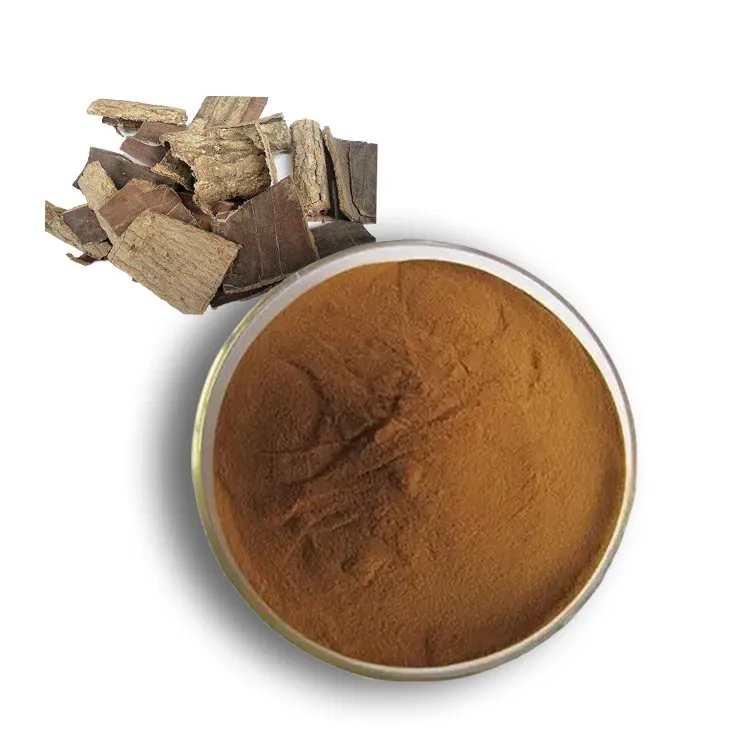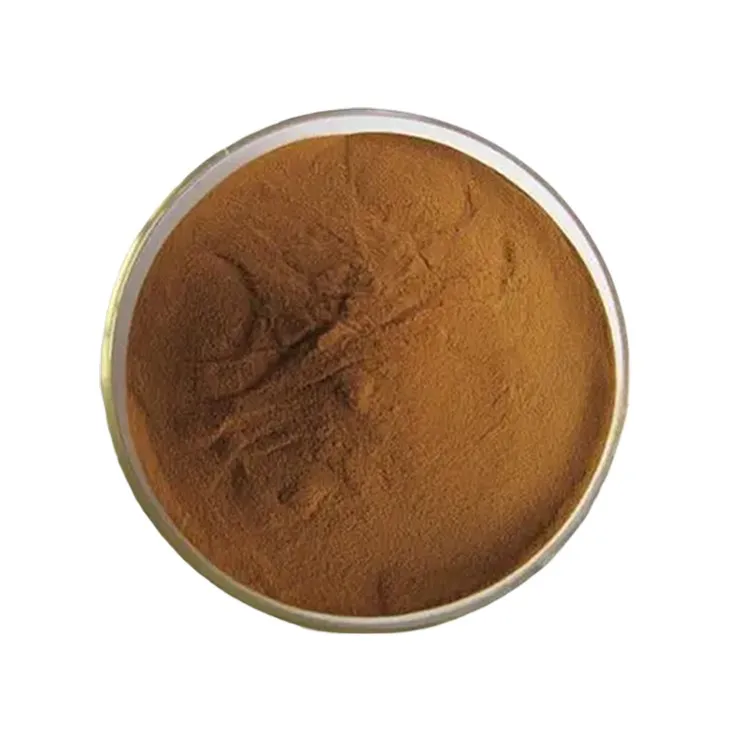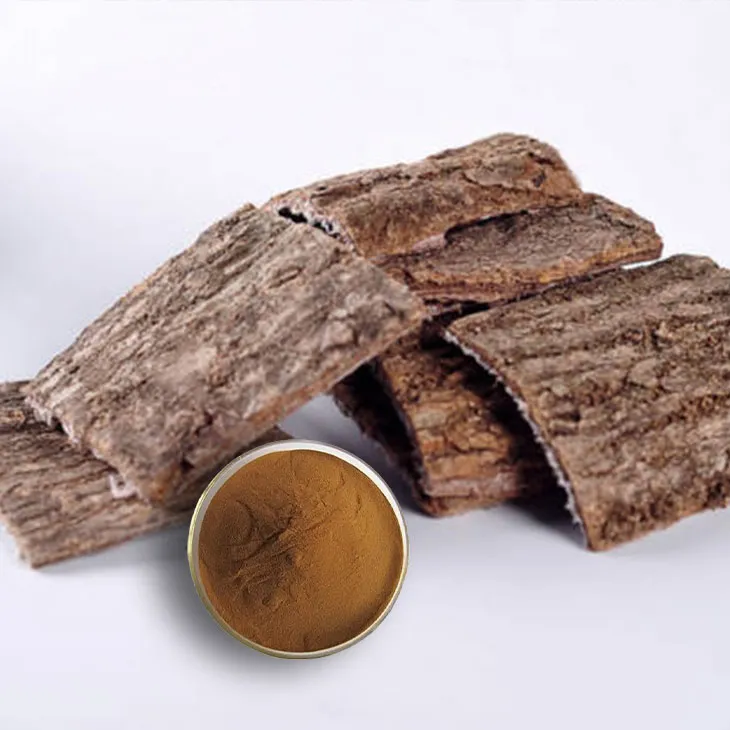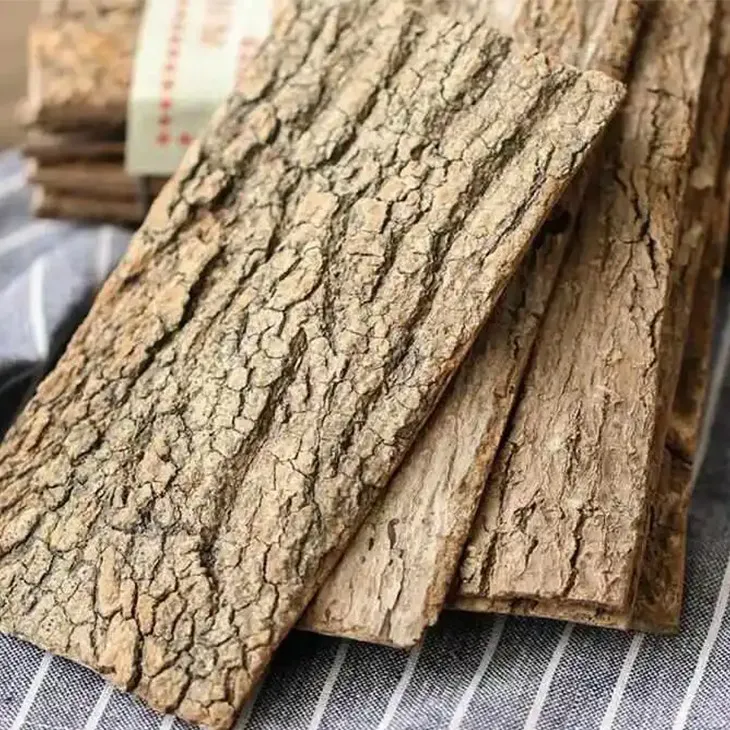- 0086-571-85302990
- sales@greenskybio.com
The process of extracting pinoresinol diglucoside from Eucommia ulmoides extracts.
2024-11-28

1. Introduction to Eucommia ulmoides and Pinoresinol Diglucoside
Eucommia ulmoides is a remarkable plant that has been highly regarded in traditional medicine for its various potential health - promoting properties. It is rich in a variety of bioactive compounds, among which pinoresinol diglucoside is of particular interest.
Pinoresinol diglucoside has attracted significant attention due to its potential pharmacological activities. It is believed to possess antioxidant, anti - inflammatory, and other beneficial properties. The extraction of pinoresinol diglucoside from Eucommia Ulmoides Extract is a complex yet scientifically interesting process.

2. The Initial Extraction Step: Obtaining the Crude Extract
2.1 Maceration Method
Maceration is one of the traditional and commonly used methods for the initial extraction. In this process:
- The plant material of Eucommia ulmoides is first dried and ground into a fine powder. This step is crucial as it increases the surface area of the plant material, allowing for better solvent penetration.
- A suitable solvent, such as ethanol or methanol, is then selected. The choice of solvent depends on various factors including the solubility of pinoresinol diglucoside and the cost - effectiveness of the solvent. Ethanol is often a preferred choice due to its relatively low toxicity and good solubility properties.
- The powdered Eucommia ulmoides is then soaked in the solvent in a sealed container for a certain period of time, usually ranging from several days to weeks. During this time, the bioactive compounds, including pinoresinol diglucoside, gradually dissolve into the solvent.
- After the maceration period, the mixture is filtered to separate the liquid extract (containing pinoresinol diglucoside) from the solid residue. The filtrate obtained is the crude extract which contains a mixture of various compounds along with the desired pinoresinol diglucoside.
2.2 Soxhlet Extraction
Soxhlet extraction is another popular method for obtaining the initial extract:
- The dried and powdered Eucommia ulmoides is placed in a Soxhlet thimble. This thimble is then inserted into the Soxhlet apparatus.
- A suitable solvent, similar to that used in maceration, is placed in the main flask of the Soxhlet apparatus. The solvent is heated to reflux continuously.
- As the solvent vaporizes, it rises through the sidearm of the Soxhlet apparatus and condenses in the condenser above the Soxhlet thimble. The condensed solvent then drips onto the plant material in the thimble, extracting the bioactive compounds.
- The advantage of Soxhlet extraction is that it is a continuous extraction process. The solvent is recycled and reused for extraction, which can lead to a more complete extraction of pinoresinol diglucoside compared to simple maceration. However, it also has some drawbacks, such as a relatively long extraction time and the need for more complex equipment.
- Once the extraction is complete, the solvent is evaporated to obtain the crude extract, which also contains a complex mixture of compounds including pinoresinol diglucoside.

3. Purification of the Crude Extract: Separation Technologies
3.1 Preparative Thin - Layer Chromatography (PTLC)
After obtaining the crude extract, the next step is purification, and preparative thin - layer chromatography is a useful method:
- A suitable stationary phase, such as silica gel, is coated on a glass plate. The crude extract is then dissolved in a suitable solvent and carefully spotted near the bottom of the plate.
- A mobile phase, which is a mixture of solvents with different polarities, is then allowed to ascend the plate by capillary action. As the mobile phase moves up the plate, the different compounds in the crude extract, including pinoresinol diglucoside, are separated based on their different affinities for the stationary and mobile phases.
- The separated bands can be visualized using different techniques, such as UV light or chemical staining. The band corresponding to pinoresinol diglucoside can then be scraped off the plate.
- The scraped material is then eluted with a suitable solvent to obtain a more purified form of pinoresinol diglucoside. However, PTLC has some limitations. It is a relatively time - consuming process, and the amount of sample that can be purified in one run is limited.
3.2 Gel Filtration Chromatography
Gel filtration chromatography is another effective purification method:
- A gel matrix, such as Sephadex, is packed into a column. The crude extract is dissolved in a suitable buffer and loaded onto the top of the column.
- The buffer is then pumped through the column at a constant flow rate. As the sample moves through the column, the different compounds are separated based on their molecular sizes. Larger molecules are excluded from the pores of the gel matrix and move through the column more quickly, while smaller molecules, like pinoresinol diglucoside, enter the pores and are retarded in their movement.
- The fractions containing pinoresinol diglucoside are collected as they elute from the column. Gel filtration chromatography has the advantage of being able to handle relatively large sample volumes and can provide good separation of compounds with different molecular sizes. However, it also requires careful optimization of the column packing, flow rate, and buffer composition.

4. Optimization of the Extraction Process
To efficiently extract pinoresinol diglucoside from Eucommia Ulmoides Extract, optimization of each step in the process is essential:
- Solvent Selection and Concentration: The choice of solvent and its concentration can significantly affect the extraction efficiency. Different solvents may have different solubilities for pinoresinol diglucoside. Moreover, the concentration of the solvent can also influence the extraction rate. For example, a higher concentration of ethanol may extract more pinoresinol diglucoside in a shorter time, but it may also extract more unwanted compounds.
- Extraction Time: In both maceration and Soxhlet extraction, the extraction time is an important factor. Too short an extraction time may result in incomplete extraction of pinoresinol diglucoside, while too long an extraction time may lead to the extraction of excessive amounts of unwanted compounds or may even cause degradation of the target compound.
- Temperature: Temperature also plays a role in the extraction process. In Soxhlet extraction, the temperature of the solvent reflux can affect the extraction efficiency. A higher temperature may increase the solubility of pinoresinol diglucoside in the solvent, but it may also cause thermal degradation of some compounds in the extract.
- Purification Parameters: In the purification steps, parameters such as the type of stationary and mobile phases in PTLC, and the column packing, flow rate, and buffer composition in gel filtration chromatography need to be optimized. For example, in PTLC, different ratios of the mobile phase solvents can be tested to achieve the best separation of pinoresinol diglucoside from other compounds.

5. Conclusion
The extraction of pinoresinol diglucoside from Eucommia Ulmoides Extract is a multi - step process that involves initial extraction methods such as maceration or Soxhlet extraction followed by purification using techniques like preparative thin - layer chromatography or gel filtration chromatography. Each step in the process has its own characteristics and requirements, and optimization of these steps is crucial for efficiently obtaining high - quality pinoresinol diglucoside. Through continuous research and improvement of these extraction and purification techniques, we can better utilize the potential of Eucommia ulmoides and its valuable compound pinoresinol diglucoside in various fields such as medicine and health products.
FAQ:
What are the common extraction methods for pinoresinol diglucoside from Eucommia ulmoides extract?
The common extraction methods include maceration and Soxhlet extraction. Maceration involves soaking the Eucommia ulmoides material in a suitable solvent for a period to allow the pinoresinol diglucoside to dissolve into the solvent. Soxhlet extraction is a continuous extraction method that can efficiently extract the compound from the plant extract.
Why are advanced separation technologies necessary in the extraction of pinoresinol diglucoside?
Advanced separation technologies such as preparative thin - layer chromatography or gel filtration chromatography are necessary because the initial extract obtained from the extraction methods contains not only pinoresinol diglucoside but also other components. These separation technologies can purify the pinoresinol diglucoside, removing the impurities and obtaining a more pure product.
How can we optimize the extraction process of pinoresinol diglucoside?
To optimize the extraction process, factors such as the choice of solvent, extraction time, temperature, and the ratio of plant material to solvent need to be considered. For example, different solvents may have different extraction efficiencies for pinoresinol diglucoside. Also, appropriate extraction time and temperature can ensure maximum extraction without degrading the compound. Adjusting the ratio of plant material to solvent can also affect the yield of the extraction.
What are the potential health - promoting properties related to pinoresinol diglucoside?
Pinoresinol diglucoside has been associated with various potential health - promoting properties. It may have antioxidant effects, which can help protect cells from oxidative damage. It may also have anti - inflammatory properties, potentially reducing inflammation in the body. However, more research is still needed to fully understand and confirm these properties.
What are the challenges in the extraction of pinoresinol diglucoside from Eucommia ulmoides extract?
One of the challenges is the co - extraction of other compounds along with pinoresinol diglucoside, which makes the purification process more difficult. Another challenge is to find the optimal extraction conditions that can ensure high yield and purity without causing degradation of the compound. Additionally, the cost - effectiveness of the extraction process also needs to be considered, as some extraction and separation methods may be expensive.
Related literature
- Isolation and Characterization of Pinoresinol Diglucoside from Eucommia ulmoides: A Review"
- "Optimization of the Extraction Process of Bioactive Compounds from Eucommia ulmoides: Focus on Pinoresinol Diglucoside"
- "The Health - Promoting Effects of Pinoresinol Diglucoside from Eucommia ulmoides: Current Research and Future Perspectives"
- ▶ Hesperidin
- ▶ citrus bioflavonoids
- ▶ plant extract
- ▶ lycopene
- ▶ Diosmin
- ▶ Grape seed extract
- ▶ Sea buckthorn Juice Powder
- ▶ Beetroot powder
- ▶ Hops Extract
- ▶ Artichoke Extract
- ▶ Reishi mushroom extract
- ▶ Astaxanthin
- ▶ Green Tea Extract
- ▶ Curcumin Extract
- ▶ Horse Chestnut Extract
- ▶ Other Problems
- ▶ Boswellia Serrata Extract
- ▶ Resveratrol Extract
- ▶ Marigold Extract
- ▶ Grape Leaf Extract
- ▶ blog3
- ▶ blog4
-
High - quality Chasteberry Extract Products.
2024-11-28
-
China's banana juice powder suppliers.
2024-11-28
-
Bulk purchase of cranberry extract.
2024-11-28
-
How to make powder with bayberry extract?
2024-11-28
-
The best peony root extract in nature.
2024-11-28
-
100% Pure Organic Baicalin.
2024-11-28
-
Agaricus Blazei Extract
2024-11-28
-
Jujube Extract
2024-11-28
-
Tamarind extract powder
2024-11-28
-
Coix Seed Extract
2024-11-28
-
Hops Extract
2024-11-28
-
Gynostemma pentaphyllum extract
2024-11-28
-
Cocoa Extract
2024-11-28
-
Okra Extract
2024-11-28
-
Baicalin
2024-11-28
-
Marigold Extract
2024-11-28





















